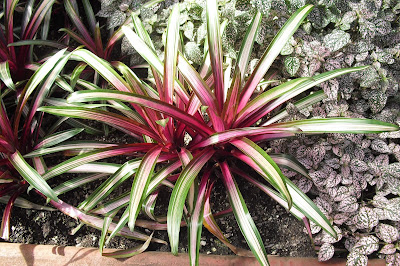As much as I love buying plants I've never tried before, I find more and more that my plant shopping is focused on replacements. Plants that I've had, loved and lost. Whether I made cultural gaffes, or the plant was lost to pests, I am eager to try these plants again:
Aglaonema 'Peacock' and Aglaonema 'Cory': I've come to the conclusion that I'm just not good with Aglaonemas. I don't know why; they are supposedly easy plants. My mother, who insisted that she was no good with plants, had two that flourished. I inherited them when she died, and managed to kill them too. Anyway, I would still like to try again with A.'Peacock' and A.'Cory', but these days, no one carries the green, white-stemmed Aglaonemas anymore. I love the red and pink ones as much as the next crazy plant lady, but I'd like to see some of the older varieties on sale.
Alpinia zerumbet 'Variegata': I lost my two plants to scale insects. While I have been able to fight scale and win at least twice, (with my huge ZZ plant and my Monstera deliciosa) I generally don't fool around with it. It's hard to treat and spreads like wildfire. My general rule is that scale-infested plants have got to go.
Begonia 'Cracklin' Rosie': A beautiful plant that did beautifully for years, till all of a sudden, with no change in care, it started to decline and continued until it died.
Dracaena reflexa 'Song of India': I lost one to cultural mistakes, (not enough light, inconsistent watering) and another to the dreaded scale. The third was very large, and was doing so well until it was attacked by mealybugs. Trying to get them out of the dozens of crevices where the leaves join the stems was impossible. Then the mealybugs attracted ants. A disaster all around.
Echeveria (any species or variety:) I lost the bulk of my collection to mealybug. I am slowly but steadily replacing them.
 |
| Part of my current collection of Echeveria (and Graptopetalum) |
That certain Saintpaulia: The flowers were close to sky blue as possible for an African Violet, and outlined in white. It has been close to 30 years since I lost it, (I was a complete AV newbie, and I repotted it into too large a pot) and I've never come across anything like it again. This is more than a quest, it is a crusade. I won't rest until I find something that looks like it.
Then there are the plants that I have sworn to never buy again. I made this list about 9 years ago, and to tell the truth, I find myself wavering on it. Several of these plants have tempted me in recent years, so take the "never" with a grain of salt.
Aphelandra squarrosa: It's been years since I have had one. The memories of constant leaf drop are as fresh as if I tossed my last one yesterday.
Begonia rex: Even the popular "Houseplant Expert" book calls them short-lived. They can live their short lives with someone else.
Calathea, Ctenanthe, Maranta, Stromanthe: These related genera are not difficult to keep alive, just hard to keep presentable without proper humidity. The edges of the leaves get dry and brown. Even the Calathea zebrina I saw at the Garfield Park Conservatory had crispy edges
 |
| Calathea zebrina at the Garfield Park Conservatory. Even in their humid enviroment, the leaf edges dry out. |
Cissus discolor: Sometimes called the rex begonia vine. Enough said.
Dieffenbachia: Not culturally difficult--I just don't like them much.
Dracaena marginata: See Dieffenbachia.
Lithops: Their care requirements are beyond me, it seems. Since I'm a chronic underwaterer, I doubt that I overwater them. Maybe it was a light issue. At this point, I don't care to find out.
Monstera obliqua (or M. adansonii, or M. friedrichsthalii): Whatever the actual Latin binomial, those vining swiss-cheese plants are as difficult for me to grow as they are to identify.
Peperomia argyreia and Peperomia caperata: I give them what they are supposed to like, and what do they do? Die, that's what.
Philodendron scandens: Yes, the easy plant that anyone can grow. For some reason I can't. It's like Aglaonema. I just don't have what it takes. Unlike with the Aglaonemas, I don't care to try again.
Sansevieria trifasciata 'Hahnii' (any variety): In my opinion, Sanseviera trifasciata in general isn't quite as easy as their reputation suggests. But I do well with them. Except the various bird's nest types. Those seemingly come to my house to die.
Spathiphyllum: Apparently, I can't be trusted with anything that reacts that dramatically to underwatering.
Well, there are the "always" and "never" lists. What about the "sometimes" in the title? That list consists of every other houseplant you can imagine. If it's out there, I'll probably try it at some time or another.
Addendum: Shortly after finishing this post, I went through the archives and discovered that I had posted a version of the
never again list previously, shortly after I compiled it in 2009. The more things change, the more they stay the same.




















































